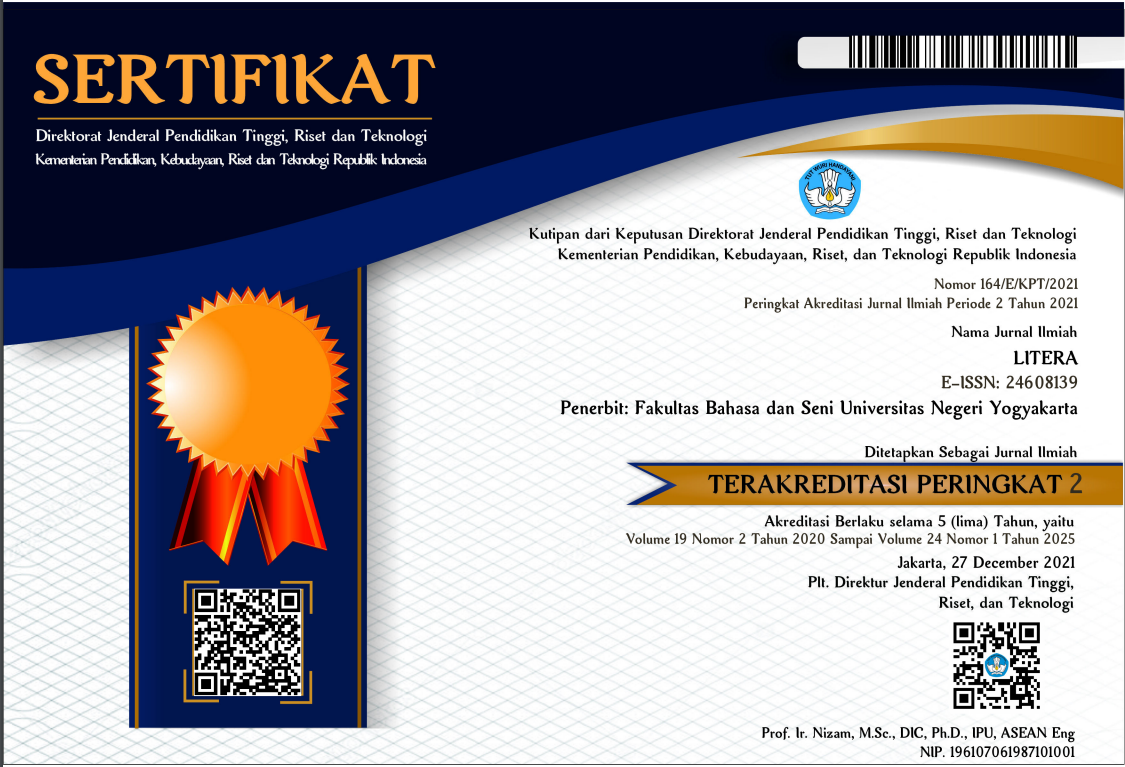STRUCTURE, FUNCTION, AND INHERITANCE SYSTEM OF THE GAMBANG RANCAG ORAL TRADITION IN THE BETAWI COMMUNITY
Abstract
STRUCTURE, FUNCTION, AND INHERITANCE SYSTEM OF THE GAMBANG RANCAG ORAL TRADITION IN THE BETAWI COMMUNITY
Abstract
Jakarta is inhabited by people formed from a melting plot process, namely mixing of various ethnicities and regions, both from within and outside Indonesia. From the melting plot process, the position of the Betawi people changed to a new identity called the Betawi tribe or the Betawi people. This aims of study is to describe the structure, function, and inheritance sistem of the gambang rancag oral tradition in the Betawi community. This research was conducted in four areas of DKI Jakarta and another area in West Java, namely Depok. The choice of location of this research was carried out because objectively these areas were the population base of the Betawi community. Data collection by observation, interview and documentation study. Data analysis with interdisciplinary approach, structural theory in Abrams and G. L. Koster Malay poetry, Albert Lord's formula theory and inheritance sistem, and Functions by Alan Dundes and Teeuw. The results of this study were first, describing the existence of communication between the creator, the text, the audience, and the community that can be considered through the text structure (1) the flow scheme, (2) the theme, and (3) the character's actions. Second, functions, were (1) affirmation function, (2) negation function, and (3) restoration function. The third, were the inheritance sistem, includes: (1) giving the model, (2) modeling the model, and (3) showing the model.
Keywords: oral tradition, gambang rancag , structure, function, inheritance, Betawi community
STRUKTUR, FUNGSI, DAN SISTEM PEWARISAN
TRADISI LISAN GAMBANG RANCAG PADA MASYARAKAT BETAWI
Abstrak
Jakarta didiami oleh masyarakat yang terbentuk dari proses melting plot, yaitu percampuran dari berbagai etnik dan wilayah, baik dari dalam maupun luar Indonesia. Dari proses melting plot, kedudukan orang Betawi berubah menjadi identitas baru yang dinamakan suku Betawi atau orang Betawi. Penelitian ini bertujuan mendeskripsikan struktur, fungsi, dan sistem pewarisan tradisi lisan gambang rancag pada masyarakat Betawi. Penelitian ini dilaksanakan di empat wilayah DKI Jakarta dan satu daerah di Jawa Barat, yaitu Depok. Pemilihan lokasi penelitian ini dilakukan karena secara objektif daerah-daerah tersebut merupakan basis penduduk masyarakat Betawi. Pengumpulan data dilakukan dengan observasi, wawancara, dan studi dokumentasi. Analisis data dilakukan dengan pendekatan interdisiplin, teori struktur puitika Melayu Abrams dan Koster, teori formula dan sistem pewarisan oleh Lord, dan fungsi oleh Dundes dan Teeuw. Adapun hasil penelitian ini, yaitu pertama, menggambarkan adanya komunikasi antara pencipta, teks, penonton, dan masyarakat yang dapat diperhatikan melalui struktur teks (1) skema alur, (2) tema, dan (3) lakuan tokoh. Kedua, fungsi, yaitu (1) fungsi afirmasi, (2) fungsi negasi, dan (3) fungsi restorasi. Ketiga, yaitu sistem pewarisan, meliputi: (1) memberikan model, (2) mencontoh model, dan (3) mempertunjukkan model.
Kata Kunci: tradisi lisan, gambang rancag , struktur, fungsi, pewarisan, masyarakat Betawi
Keywords
Full Text:
PDFReferences
Abrams, M.H. (1976). The Mirror and the Lamp: Romantic Theory and the Ctritikal Tradition. London, Oxford, New York: Oxford University Press.
Castle, L. (1967). The Etnnic Profile of Jakarta, Indonesia. (Volume III, April 1967). Ithaca-New-York: Cornel University.
Gazali. (2016). Struktur, Fungsi, dan Nilai Nyanyian Rakyat Kaili. Litera: Jurnal Penelitian Bahasa, Sastra, dan Pengajarannya. 15(1), 189-199. DOI: https://doi.org/10.21831/ltr.v15i1.9778.
Hasan, ABP. & Suwarni, E. (2012). Policies and Practice for Promoting Multicultural Awarennes of Indigenous Early Chilhood Education in Indonesia. Internasional Journal od Child Care and Education Policy, 6 (1), 63-94.
Heuken, SJ. (1997). Historical Sites of Jakarta. Jakarta: Cipta Loka Caraka.
Koster, G. L. (2008). Roaming Through Seductive Gardens. Leiden: KITLV Press.
Lord, A. B. (2000). The Singer of Tales. London: Harvard University Press.
Ong, W. J. (1982). Orality and Literacy: The Technologizing of the word. London: Methuen.
Ramakrishnan, M. (2016). Relevance and Significance of Oral Tradition and Cultural Heritage. In Oral Tradition and Cultural Heritage of Punjab. Singh Surjeet. Punjab: Publication Bureua Punjabi University.
Rhett, M. B. (1987). The Structure and Changing Function of Oral Traditions. Oral Tradition. 2 (2-3), 645-655.
Ridwan, M. & Wahdian, A. (2017). Structure, Functioan, and Value The Tradition of Oral Literature in Sumenep Madura. Journal of Lietature Studies on Language, Art, and Culture, 1(1), 252-273.
Ruchiat, R. (1981). Proyek Konservasi Kesenian Tradisional Betawi: Pendekatan Sejarah dan Latar Belakang Sosial Budaya Gambang Rancag . Jakarta: Dinas Kebudayaan Provinsi DKI Jakarta.
Ruchiat, dkk. (2003). Ikhtisar Kesenian Betawi. Jakarta: Dinas Kebudayaan dan Permusiuman Provinsi DKI Jakarta.
Salleh, M.H. (1992). Sajak-Sajak Sejarah Melayu. Malaysia: Dewan Bahasa dan Pustaka.
Setiartin, T. R. (2015). Transformasi Teks Cerita Rakyat ke dalam Bentuk Cerita Bergambar sebagai Model Pembelajaran Membaca Apresiatif. Litera: Jurnal Penelitian Bahasa, Sastra, dan Pengajarannya, 15(2), 389-401. DOI: https://doi.org/10.21831/ltr.v15i2.11837.
Sibarani, R. (2012). Kearifan Lokal: Hakikat, Peran, dan Metode Tradisi Lisan. Jakarta: Asosiasi Tradisi Lisan (ATL).
Sopandi, A., dkk. (1999). Gambang Rancag . Jakarta: Dinas Kebudayaan DKI Jakarta.
Sweeney, A. (1980). Authors and Audiences in Traditional Malay Literature. Berkley: University of California Press.
Suswandari. (2017). Lokal History of Jakarta and Multicultural Attitude (Hitorical Local Study of Betawi Ethnic. Jurnal of Education, Theacing And Learning, 2(1), 93-100.
Teeuw, A. (1994). Indonesia Antara kelisanan dan Keberaksaran. Jakarta: Pustaka Jaya.
Udu, H., Kusuma, INW., & Alifudin, M. (2016). Inheretance Strategy for Endangered Oral Tradition in The Archipelago (Case Study in Inheritence of Kangkilo Oral Tradition. International Journal of Linguistic, Language and Culture, 2(3), 56-62. DOI: http://dx.doi.org/10.21744/ijllc.v2i3.215.
Zaini, M. (2014). Cerita Lisan “Yong Dollah”: Pewarisan dan Resistensi Budaya Orang Melayu Bengkalis. Jurnal Madah, 5(1), 1-14. DOI: http://dx.doi.org/10.31503/madah.v5i1.520.
DOI: https://doi.org/10.21831/ltr.v18i1.21992
Refbacks
- There are currently no refbacks.
______________________
__________________________________________________________________________________________________
Litera Journal is published by the Faculty of Languages, Arts, and Culture Universitas Negeri Yogyakarta in collaboration with Himpunan Sarjana Kesusasteraan Indonesia (HISKI)
The International Journal of Linguistic, Literature, and Its Teaching at http://http://journal.uny.ac.id/index.php/litera/ is licensed under a Creative Commons Attribution-ShareAlike 4.0 International License
__________________________________________________________________________________________________















